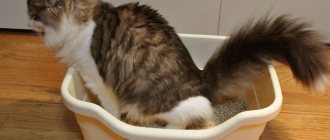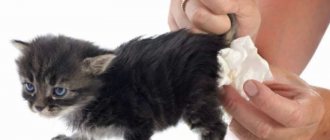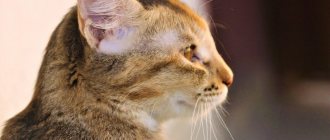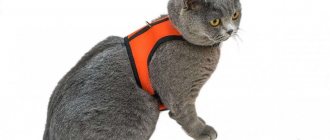The curiosity and active lifestyle of domestic cats often play a cruel joke on them, causing a foreign object to enter the gastrointestinal tract. The owner of a furry fidget must know not only the symptoms of the disease, but also what to do in such a situation, what danger a foreign object poses in the animal’s body. Often, in order to save the life of a pet, a veterinarian has to resort to surgery.
Why does a cat swallow objects?
Experienced breeders and veterinarians know that most often the penetration of foreign bodies occurs through the digestive tract. Curious cats, playing with various objects that come into their field of vision, often swallow them. Especially often, during the operation, veterinarians discover caps from valerian, parts of children's construction sets, coins, construction waste, and burst balloons.
The peak of calls regarding animals swallowing a foreign object usually occurs during the New Year holidays. Bright tinsel, small Christmas tree decorations, parts of garlands, and Christmas tree decorations attract the attention of curious cats with their shine and rustle.
Furry couch potatoes are partial to handicraft items (threads, needles, buttons, decorative elements) and fishing gear (line, hooks, spoons, wobblers, etc.).
The risk group includes small kittens and young animals. Due to natural curiosity and lack of life experience, young animals try new objects and often swallow them. Animals left to their own devices for a long time are also at risk. A bored cat tries to entertain itself by playing with foreign objects. Veterinarians also consider hair balls in a cat's stomach to be a dangerous foreign body.
We recommend reading about how to cure a cat’s runny nose and sneeze at home. You will learn about the possible causes of sneezing in cats, home treatment methods, and preventive measures. And here is more information about why a cat coughs, as if it was choking.
Diagnosis of suspected foreign body in the gastrointestinal tract of a cat or dog
Due to such a wide variety of clinical manifestations, the approach to diagnosing a foreign body in the gastrointestinal tract must be very responsible. The diagnosis begins with collecting an anamnesis: they find out from the owner whether he has witnessed his animal eating any objects, whether he has noticed tendencies towards similar behavior in his cat or dog, whether his pet likes to play with toys, etc.
The veterinarian asks the owner about the symptoms of the disease: whether there is vomiting, its frequency and nature, whether the appetite is suppressed, whether there is defecation, its frequency and nature, whether the animal is depressed. Since the diagnosis of “foreign body in the gastrointestinal tract” is very common and its symptoms are very varied, such a differential diagnosis is almost always made for symptoms of damage to the digestive tract, especially if there is a history of vomiting.
Next, the animal is examined and a physical examination is carried out. The veterinarian examines the oral cavity of cats and dogs to exclude the presence of foreign bodies in it (long objects can get stuck in the mouth, threads can wrap around the root of the tongue and injure it). Thermometry, examination of visible mucous membranes, and assessment of the size and tenderness of the lymph nodes are carried out. The abdominal area must be palpated. During palpation, foreign objects may be detected, abdominal pain and bloating may be detected.
Is a foreign body really dangerous?
A foreign body entering the digestive tract can lead to the following health problems:
- dehydration due to vomiting and the animal’s refusal to drink water;
- pathologies of cardiac activity up to complete cardiac arrest due to penetration of a sharp object through the wall of the stomach into the pericardium;
- violation of the integrity, numerous ruptures and damage to the mucous membrane throughout the gastrointestinal tract when a foreign body moves due to peristalsis;
- ulcerative lesions of the stomach, small and large intestines;
- necrotic processes due to prolonged presence of non-sterile objects in internal organs;
- blockage, intussusception, intestinal obstruction;
- perforation of the walls of internal organs with sharp objects;
- peritonitis with a high mortality rate.
Veterinary specialists, understanding the danger of a pet swallowing an inedible object, strongly recommend that owners closely monitor their pets and have an idea of what clinical signs are typical for this situation.
If a cat or dog ate Christmas tree rain (tinsel)
For cats, the most dangerous time of year is winter due to the New Year holidays - the tendency to eat tinsel, rain and other New Year's decorations often results in serious problems for them. <. alt=”the cat ate the tinsel from the Christmas tree” src=”/upload/medialibrary/82a/82a6ded5b9b395aa29bf8c68c4167ef0.jpg” title=”the cat ate the tinsel from the Christmas tree” contentScore=”18882″>
Dogs suffer most from ingesting bones, parts of toys, and pieces of sticks they play with. The most dangerous consequences are caused by the ingestion of sharp objects that can lead to perforation of the gastrointestinal tract, and thin, oblong objects (rags, tinsel, etc.) - they are the most difficult to identify during a physical examination and visualize using instrumental methods, and the symptoms will be no less threatening.
Symptoms in a cat
Ingestion of a foreign object does not always occur before the eyes of the owner. The discovery of the loss of one or another item in the room and the inadequate condition of the cat should cause alarm among household members and force them to take a closer look at the presence of the following symptoms in the pet:
- When an inedible object gets stuck in the esophagus, severe salivation is observed.
- When an object is localized in the pharynx, the cat coughs, wheezes, and may experience cyanosis of the tongue and loss of consciousness.
- The animal is anxious, stretches its neck, and makes frequent swallowing movements.
- Constant vomiting, belching. The duration of vomiting can last from several hours to several days, depending on the severity of the damage to the digestive canal and the location of the object.
- Complete lack of appetite, the animal refuses even its favorite treat.
- Pain in the abdomen, accumulation of gases, bloating.
- Lethargic and apathetic state, drowsiness.
- Stool retention, diarrhea, constipation.
- Reducing the amount of feces.
- With chronic obstruction, cachexia develops due to decreased appetite.
- Signs of general intoxication of the body.
Bearing in mind the danger of foreign bodies entering the gastrointestinal tract of a domestic cat, the owner should immediately take the animal to a specialized clinic.
How does a cat behave with a bone in its respiratory tract?
The behavior of a cat caught in such a situation will definitely change. The owner should be alarmed if:
- There is a lack of appetite - if your pet refuses even treats, then perhaps he has a bone stuck in his esophagus.
- There are signs of suffocation, and the cat is breathing frequently and heavily.
- The cat itself makes attempts to get rid of the foreign object, clears its throat, makes appropriate movements and helps itself with its paws.
- Salivation (salivation) increases.
- Exhausting, suffocating spasms of the larynx occur, as with a sore throat.
- The cat is vomiting; there may be a urge to vomit, accompanied by characteristic sounds.
Some cats get scared, begin to avoid people, hide from view and let out a plaintive meow. Prolonged restlessness of a pet is an alarming sign for the owner. If this happens, it means that the animal was unable to cope with the problem on its own and needs human help.
What to do when a cat swallows an object
Veterinary experts strongly recommend that owners who discover that a cat has swallowed a foreign body not take any independent action. Lack of professional skills and knowledge will lead to even more severe consequences for the pet’s health.
For example, you should not give petroleum jelly, which can cause intussusception when a foreign body is in it. Under no circumstances should you induce vomiting if there is a suspicion that a sharp object, alkali or petroleum product has been swallowed.
The owner must ensure that the animal does not take food or water before visiting the veterinarian, provide the cat with complete rest and urgently take it to a specialized clinic.
X-ray
The main instrumental method for diagnosing a foreign body in the digestive tract is still an x-ray examination, carried out in at least two projections: ventro-dorsal (direct) and lateral (lateral).
The study can be carried out either with or without the use of a contrast agent. If the swallowed object is metallic, then it is most often radiopaque and clearly visible on the image. Stones and bones also have high radiological density. Even if the foreign body itself is not displayed on the image, some findings may indicate an appropriate diagnosis: “collected” intestinal loops, accumulation of gases in a certain area of the intestine may indicate its location.
If the foreign body is not radiopaque, a contrast agent is often used to determine the location of the obstruction. The animal is most often given barium sulfate or the more modern iodine-containing drug Omnipaque, and then a series of x-rays are taken at regular intervals.
In a healthy cat or dog, the liquid is evenly distributed in the lumen of the gastrointestinal tract and does not linger in any of the sections longer than necessary, and is then evacuated with feces. With obstruction, the solution stops or slows down its progress in the corresponding part of the digestive system, which is displayed in the image.
Diagnostics in a veterinary clinic
After taking a history and physical examination, the veterinarian begins special examination methods to visualize the foreign object. The following diagnostics are used in veterinary practice:
- Survey radiography of the abdominal organs. It is carried out in two projections: direct and lateral. For a more detailed study, radiography is carried out in a vertical and horizontal position of the furry patient. The method allows you to determine the presence and location of radiopaque objects (metal needles, paper clips, etc.).
On the radiograph: a penny in the intestines of a cat
- To visualize foreign objects such as plastic, threads, a radiopaque substance is used, which is injected into the animal’s body.
- Ultrasound examination of the digestive canal and organs of the thoracic and abdominal cavity. The method allows you to detect intestinal obstruction and determine the state of intestinal motility.
- Using a fiber optic fiberscope, your pet will undergo an endoscopic examination of the esophagus and stomach in a specialized institution. The method is effective if no more than 3-4 hours have passed since the foreign body was swallowed.
Laboratory methods for examining blood and urine are of an auxiliary nature and are necessary for the differential diagnosis of intestinal obstruction due to an infectious disease, intoxication, etc.
First aid
It is important that the owner immediately pays attention to the condition of the pet. You need to act according to the algorithm:
- Wrap the animal in a diaper or blanket to limit physical activity. Leave only your head free.
- Conduct a thorough examination of your pet's oral cavity. To look into his mouth, you need to carefully move the lower jaw down with the pressure of one finger.
- If a foreign object is visible, then you should try to pull it out using tweezers. It is not recommended to use your fingers in the cat's mouth. It is unlikely that you will be able to remove the bone in this way, but driving it much deeper and aggravating the situation is as easy as shelling pears.
To make the procedure more effective, it is better to involve an assistant in it.
Together, it is easier to fix the resisting “patient” and avoid possible injuries.
The bone is not in the throat. If a foreign object is not found in the pharynx, then further examination of the mouth should be abandoned. In this case, other actions are necessary to push it out:
- You need to confidently slap your pet on the back, choosing the area between the shoulder blades. The movement should be careful, but clear.
- You can quickly squeeze the cat's chest from the sides. The person needs to sit on the floor with the animal's croup facing him. The hind limbs should be raised and clamped with the knees. Place your hands on the cat's sides and squeeze the sternum to about 1/3 of its volume. You can’t fuss and push hard.
Such actions are aimed at provoking a cough, during which the cat itself can push out the bone that causes discomfort.
Removal by operation
You can preserve the health, and sometimes even the life, of your beloved pet if it swallows foreign objects with the help of surgical intervention performed by an experienced veterinarian.
From the intestines
When intestinal obstruction is confirmed by radiographic and ultrasound methods, the surgeon, as a rule, decides to perform diagnostic laparoscopy. During the operation, the foreign body is removed and the intussusception is reduced. If necessary (in cases of necrosis), part of the intestine is resected.
To learn how to remove a foreign object from a cat’s intestines using enterotomy, watch this video:
From the stomach
In rare cases, it is possible to remove a foreign object from the stomach using diagnostic gastroscopy. If a foreign body is detected in the stomach of a domestic cat using endoscopic, x-ray or ultrasound examination, the surgeon usually decides to perform a gastrotomy.
Removal of threads from the stomach during gastrotomy
Having gained immediate access, the stomach is held in place using ligatures. The foreign body is removed using instruments or palpation. After suturing the mucous membrane and muscle layers, the organ is returned to its anatomical location. The operation is performed under general anesthesia.
From the esophagus
If the location of the foreign body is the esophagus, in some situations it is possible to remove it using an endoscope. If the object is large, the surgeon can perform an esophagotomy. The operation is indicated if the x-ray shows perforation of the walls of the esophagus, or the foreign body is large and has sharp edges.
Often the veterinarian resorts to the following manipulation. Using an endoscope, an object is pushed into the stomach, after which the animal undergoes a gastrotomy, followed by removal of the foreign body.
Removing a foreign body (needle and thread) using an endoscope.
After laparotomy, gastrotomy or esophagotomy, the animal is prescribed a 24-hour fasting diet. Subsequently, the operated pet receives liquid food in small portions. Weakened and dehydrated animals must undergo infusion therapy. To prevent peritonitis and postoperative complications, a course of antibacterial drugs is prescribed.
In complicated cases, the pet is left after surgery for 2-3 days in a specialized institution, using parenteral nutrition. A follow-up ultrasound examination is required after surgery.
We recommend reading about why a cat has bloody stool. You will learn about the reasons for the appearance of blood in the stool, the actions of the owners before going to the veterinary clinic, diagnosis and treatment. And here is more information about how to give an enema to a cat.
Did your dog or cat swallow a bone? What to do? What are the symptoms? Expert advice.
What to do and what are the symptoms if your dog or cat swallows a bone, sock, needle or ball - let's figure it out!
*The article was written based on an analysis of my clinical data (more than 1200 cases) of surgical treatment of cats and dogs that swallowed foreign objects from 2013 to 2021.
Author of the article: Mezin Andrey Vladimirovich
If you contact our veterinary clinic in a timely manner, we can remove the object without surgery!
WHAT TO DO?
In my medical practice, every day I have to deal with clinical cases of removing foreign objects from domestic animals.
The greatest danger is a foreign object, which, after being eaten by an animal, can get stuck in the esophagus or intestines, causing necrosis (death of soft tissue) and, as a result, the death of the animal. It is important for the owner to know the symptoms that characterize obstruction (blockage) of the gastrointestinal tract (GIT) by a foreign object. Symptoms have certain differences, depending on the part of the gastrointestinal tract (esophagus, stomach, intestines) in which the blockage occurred with a foreign object. IF A FOREIGN OBJECT IS IN THE ESOPHAGUS The dog ate a bone, a toy and it got stuck in the esophagus - symptoms: • Frequent bouts of vomiting (up to 30 times per hour) • Heavy breathing, wheezing • Instant vomiting when drinking water or food
The cat swallowed a bone, a needle and it got stuck in the esophagus - symptoms: • Frequent attacks of vomiting (similar to a cat regurgitating hair) up to 20 times per hour • Profuse drooling (in half of the cases) • Heavy breathing, wheezing
WHAT IS THE DANGER?
I would like to note that a foreign object stuck in the esophagus can lead to the worst possible outcome for the animal if help is not provided in time! Most often, medium-sized hard objects with sharp or irregular edges get stuck there.
The esophagus passes through the chest cavity, and if you do not seek help from a specialist in time, then on the 3rd day of compression by a foreign object on the wall of the esophagus, necrosis of the mucous layer develops (moderate). On days 5-7 there is a perforation (hole) in the chest cavity, which in almost 90% of cases will lead to the death of the animal.
HOW TO HELP
It is important not to waste precious time and take the animal to a veterinary clinic that has specialized and modern equipment, and most importantly, specialists who understand this issue.
Help should begin with diagnosis - initially an x-ray is taken, in the image you can clearly see the foreign object and its location.
The next step is under anesthesia, an examination is carried out with a gastroscope (camera), which is inserted through the mouth into the esophagus. The foreign object is inspected and, depending on its shape and position, removed with special flexible or rigid instruments, also through the animal’s mouth. The removal of the object itself takes place as safely and quickly as possible, without stitches or incisions, without long courses of IVs and injections, but with early access to the clinic (on the first day).
WE CAN REMOVE A FOREIGN OBJECT WITHOUT SURGERY - 8(495)194-82-52
IF A FOREIGN OBJECT IS IN THE STOMACH
It can be more difficult to diagnose a foreign object in the stomach, since in the first stages the clinical picture can be vague, but there are still general symptoms.
The dog swallowed a ball, a sock and it is in the stomach - symptoms: • vomiting on an empty stomach (3-5 times a day) • vomiting 15 minutes after eating • pain in the epigastric area • cats have similar symptoms
HOW CAN I HELP YOU
The stomach is a hollow organ; for clarity, it can be imagined as a kind of container in which a foreign object can “dangle” for a long time, not always giving an obvious clinical picture. The only thing that can alert you is frequent bouts of vomiting.
I have had clinical cases where metal objects (a fish hook, a woman's ring) lay asymptomatic in the dog's stomach for more than 6 months and were accidentally diagnosed.
Most foreign objects consist of poorly x-ray contrast materials (polyethylene, fabric, thin plastic, etc.), so radiography as a research method does not always give an unambiguous result, but it must be carried out.
The most effective is gastroscopy; in one study we can examine the stomach and diagnose various gastrointestinal diseases (gastritis, ulcers, tumors) and, if necessary, remove a foreign object through the oral cavity.
WHAT IS THE DANGER?
The danger is that a foreign object of small and medium size can and will move further, from the stomach into the intestines. And it is possible to remove a foreign object from the intestines only using abdominal surgery.
WE CAN REMOVE A FOREIGN OBJECT WITHOUT SURGERY - 8(495)194-82-52
IF A FOREIGN OBJECT IS STUCK IN THE INTESTINE
This category of cases is the most numerous; obstruction most often occurs in the small intestine. As a rule, small, long/linear objects (threads, ropes, fabric, elastic bands), elastic objects made of rubber or silicone get stuck in the intestines.
The dog swallowed a sock, a bag and it is in the intestines - symptoms: • Vomiting (after eating, less often after water) • Gradually developing lethargy and apathy • Pain in the stomach and intestines upon palpation (often a foreign object in the intestines can be felt with your fingers) • In cats have the same symptoms
HOW CAN I HELP YOU
The most effective assistance can only be provided in a clinic; the sooner this happens, the better the prognosis! Diagnostics include radiography, contrast with barium sulfate (passage of barium through the intestines/lack of patency) - a series of images within 12-24 hours, diagnostic laparoscopy (a camera is inserted into the abdominal cavity through a puncture).
ATTENTION!
Do not try
induce vomiting with a solution of hydrogen peroxide, a solution of potassium permanganate, or a saline solution. Spasms and sudden contraction of the walls of the stomach and esophagus can cause bone (or other foreign object) to damage the walls of the organ and aggravate the situation, even leading to death. For the same reason, you should not give a laxative.
REMEMBER!
If your pet has one of the previously listed symptoms or you see that he has swallowed a foreign object, CONTACT A VETERINARY SPECIALIST ASAP!
Our SmartVet veterinary clinic employs experienced specialists using modern and high-tech equipment to provide timely and high-quality care to your pet.
WE CAN REMOVE A FOREIGN OBJECT WITHOUT SURGERY - 8(495)194-82-52
Endoscopy services
Prevention
Knowing about the serious consequences and threat to life when swallowing foreign objects, the owner must strictly follow the following recommendations of veterinary specialists:
- keep the room in which your furry pet lives clean;
- there should be no small items on the floor or within the reach of the animal;
- the feed must be checked for the presence of foreign impurities;
- It is unacceptable to feed a cat bones;
- Toys for your pet should be soft and large in size.
Penetration of a foreign body into the digestive canal of a pet is a dangerous phenomenon for health and life. The animal must be urgently taken to a specialized facility for special diagnostic procedures to visualize the swallowed item. As a rule, treatment comes down to surgical removal of the foreign body by laparoscopy, gastrotomy or esophagotomy, depending on its location.
Similar articles
- Foreign body.
This is not a harmless reason often... In addition to sneezing, the animal experiences shortness of breath, the cat often sleeps with its mouth open. Foreign body. This not harmless reason is often the cause of sneezing in a cat. Read more - How to give an enema to a cat correctly, is it possible to perform...
The animal stops licking itself and avoids communication. Touching the belly causes anxiety in the cat. ... traumatic injuries to the anus and intestines, including the entry of foreign bodies Read more
- Foreign body. Swallowing sharp objects...
Therefore, if a cat has blood in its stool, this indicates that the pet’s health is not in order. ... If the cause of the symptoms is a foreign body, polyps, malignant formations, then the pet can help... Read more
- How to treat a cat’s wound (open, purulent) after...
After the damaged surface is free of debris, dirt and foreign bodies, it is necessary to begin antiseptic treatment. What to use to treat an open wound on a cat... Read more
- Treatment of otitis media in cats: symptoms of purulent and fungal...
Injuries, foreign bodies entering the ear canal. ... Symptoms of otitis media in a cat. Inflammatory phenomena in the ear canal have characteristic features that cannot escape the attention of an observant owner Read more
What causes bones to get stuck in the throat?
There are several common reasons as a result of which the phraseological phrase “like a bone in the throat” turns into a real dangerous situation:
- Prolonged hunger . If a cat has not received food for a long time, it can literally attack the food, swallowing large pieces without chewing. In this case, there is a high risk that the animal will choke.
- Eating from someone else's bowl . Almost all mustachioed striped animals have a reputation for being very arrogant and unprincipled individuals who are not averse to eating from dog cups. Moreover, particularly shameless individuals may not even allow the owner to approach the bowl until they themselves “taste the dishes.” And if dogs can eat large bones without any problems, then cats may not be able to handle such food.
- Eating a whole fish . Responsible and experienced cat owners know that these pets can only be given boiled fish, previously deboned. But often whole fish, raw, are included in the diet of domestic cats. Not only can such a “delicacy” be infected with helminths, but also sharp fish bones often dig into the delicate mucous membrane of the throat, getting stuck in it or penetrating further into the esophagus and fixing there.
- Picking up street trash. This is a common problem for cats accustomed to free-ranging outside. Here they can eat any, including dangerous, objects that are not always edible.
How to keep your cat safe. The owner should monitor his pet more closely and avoid the presence of:
- duck bones;
- bones of large fish of fatty varieties: silver carp, pike, Siberian roach;
- fish tail bones, heads, as well as gills and gill covers.
If, despite all the preventive measures, a bone still gets stuck in the cat’s throat, then the owner will definitely notice warning signs.
Ultrasonography
An additional diagnostic method is ultrasound examination (US). It will help determine the presence of indirect signs of the presence of a foreign body: inflammation of the intestinal wall, the presence of gases in the stomach or intestines, lack of contraction of the walls or the so-called “pendulum peristalsis”.
Sometimes the foreign object itself can be noticeable on an ultrasound: objects in the digestive tract emit echoacoustic shadows, metal objects create a strong reverberation effect, soft foreign bodies are visible as hypoechoic formations.
Surgical diagnosis
The most rarely used diagnostic method, used only in extreme cases, is diagnostic laparotomy. This is an operation in which the abdominal wall is cut and the condition of the internal organs is assessed; When a foreign body is found, it is usually removed immediately.
This method is usually used if there are symptoms of a foreign body in the gastrointestinal tract, but instrumental methods have not shown its presence, and conservative treatment does not improve the patient’s condition.
Nowadays, thanks to the expansion of diagnostic capabilities, this method is almost never used.










